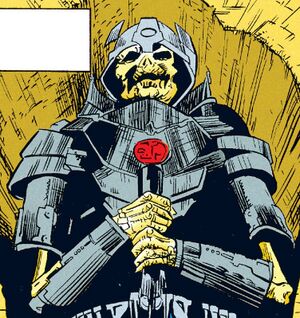Mummy/Legends
- "Yes, my mummified flesh sleeps in stone."
- ―Freedon Nadd

The name mummy was given to any corpse where the fleshy parts had been somehow preserved. Some cultures would intentionally mummify the dead so that their bodies would not decay further.
Mummies in history
The Sith, a red-skinned species from the Stygian Caldera, would embalm the corpses and wrap them in inked shrouds before entombment. Even after the Sith were subdued by a group of exiled Dark Jedi known as "the Exiles", the mummification ritual remained in use. While the majority of the new "Sith Lords" were Humans,[2] many of them were mummified, including Freedon Nadd[3] or Darsin.[4] Charms and amulets were placed in and around the mummy,[2] and the deceased's personal weapon were sometimes laid in the sarcophagus as well.[3] When Meetra Surik and her companions explored the Sith tombs on Korriban and Onderon, they found several mummies, including those of Ludo Kressh and Freedon Nadd.[5]
The Duros also practiced mummification to some extent in the distant past—as exemplified by Vardovin IV.[6] Later in history, at the time of the Galactic Civil War, Palpatine's third cousin Volpau was embalmed and wrapped in strips of cloth.[7]
Around one thousand centuries before the Galactic Civil War, an ancient civilization living on Tatooine would also mummify their dead. Those mummies were wrapped in strips of metallic cloth, then put into three-ton sarcophagi, then finally entombed in huge tumuli. One such mummy was revealed to be an abomination, a monster that could take over the mind and body of any being. This mummy had been created by ancient sorcerers to rule the galaxy, and it intended to do so by taking over body of the Galactic Emperor Palpatine.[8]
Appearances
Sources
 "Korriban: Planet of Lost Souls" (original article link) on Wizards.com (content now obsolete; backup link)
"Korriban: Planet of Lost Souls" (original article link) on Wizards.com (content now obsolete; backup link)- Book of Sith: Secrets from the Dark Side
 Nightsister zombies in the Encyclopedia (content now obsolete; backup link)
Nightsister zombies in the Encyclopedia (content now obsolete; backup link)
Notes and references
- ↑ Tales of the Jedi audio drama
- ↑ 2.0 2.1 Book of Sith: Secrets from the Dark Side
- ↑ 3.0 3.1 Tales of the Jedi 2
- ↑ A Mon Alone
- ↑ Star Wars: Knights of the Old Republic II: The Sith Lords
- ↑
 "Death, Dirt, and the Nerf Rancher's Daughter" (original article link) on Wizards.com (content now obsolete; backup link)
"Death, Dirt, and the Nerf Rancher's Daughter" (original article link) on Wizards.com (content now obsolete; backup link)
- ↑ Boba Fett ½
- ↑
 "Trois mini scénarios: Le Dieu mort"—Casus Belli 66
"Trois mini scénarios: Le Dieu mort"—Casus Belli 66